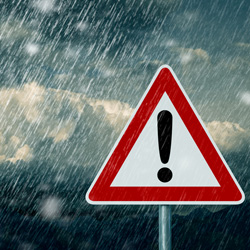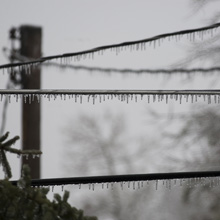 |
| The number-one cause of most power outages in the U.S. is bad weather |
What does the industry consider to be its most severe threats the U.S. electric grid? There is no shortage of nightmare scenarios.
According to the Department of Energy, the number-one cause of most power outages in the U.S. is bad weather, which costs the economy between $18 billion and $33 billion every year in lost output and wages, spoiled inventory, delayed production and damage to grid infrastructure.
When considering what’s at stake, it’s important to keep in mind that a large power transformer (LPT) is an enormous, custom-built piece of equipment tailored to customers’ specifications. They usually aren’t interchangeable with each other, and they aren’t produced for spare-part inventories, so if one blows a lot of companies and homes could be without power for more than six months. They’re not cheap, either. According to EEP (Electrical Engineering Portal), $10 million is a fairly average cost, but that doesn’t include transporting the gargantuan piece of equipment or installing it, which usually adds an additional 35 percent to the bill.
As Dave Hunt, an independent homeland security consultant and a founding member of the National InfraGard Electromagnetic Pulse special interest group, puts it, “Hurricanes, flooding, tornadoes—you know you’ll get these, so do we prepare for a rare event or do we put it [money] into more sandbags?” It’s a troubling question considering all the possible threats facing the grid. Ironically, if a utility wants to spend money to protect itself, they put themselves at a cost disadvantage, which often keeps them from making changes.
 |
| NASA estimates that a solar storm event today would make the earth go dark in about three minutes |
Solar storms. In 1859, British solar astronomer Richard Carrington witnessed a white-light solar flare—a magnetic explosion on the sun—which was so strong it was visible from earth. If we were to experience something like that now, it would have dire consequences. Not only would it disrupt the magnetic field, but it would charge the ground with electricity and that voltage could get in to a transformer and destroy it. Moreover, in today’s electronic and GPS-guided world nothing would work. NASA estimates that a comparable event today would make the earth go dark in about three minutes.
An extraordinarily large solar flare could also cause an Electromagnetic pulse event (EMP), which would plunge the world into chaos almost immediately. Cell phones and computers would stop working; electricity would be gone over a very large area, and it could take up to a year to fix; people on life-saving medical equipment would die. Whatever food is in the stores would be gone or rotten in a matter of days. Recent testimony by Peter Vincent Pry, a member of the Congressional EMP Commission and executive director of the Task Force on National and Homeland Security, indicates that an EMP event such as occurred in 1859 could wipe out half of America's population in a year.This kind of event, says Hunt, could also occur if a nation state exploded a nuclear device above the U.S. “If Iran were to ignite a nuclear bomb about 200 miles over the middle of the country, a super high pulse lasting a billionth of a second would fry any unprotected electronics. Planes would be dropping out of the sky.” Moreover, our backup generators wouldn’t work once the gas ran out.
An extraordinarily large solar flare could cause an Electromagnetic pulse event (EMP), which would plunge the world into chaos almost immediately. Cell phones and computers would stop working; electricity would be gone over a very large area, and it could take up to a year to fix; people on life-saving medical equipment would die |
Physical attack. Last April, someone or some people (no one has been caught) slipped into an underground vault and cut a couple of communications cables. Within a half hour, snipers were surgically shooting at a PG&E electrical substation in Metcalf, Calif., and taking out 17 giant transformers that power Silicon Valley. Surveillance tapes reveal that a minute before the police showed up, the perpetrators disappeared.
It took utility workers nearly a month to make repairs and bring the substation back to life. This event says Hunt, “was a very sophisticated attack,” and it is viewed by many as a trial run and a possible terrorist act that, if it were widely replicated across the country, could take down the U.S. electric grid and black out much of the country. PG&E’s response was to build a wall around the substation.
Stupidity. Last July 3, DHS replied to a Freedom of Information Act (FOIA) request on a malware attack on Google called “Operation Aurora.” Unfortunately, DHS made an enormous mistake and released more than 800 pages of documents related not to Operation Aurora but to the Aurora Project, which is a 2007 research project run by Idaho National Laboratory that demonstrates how easy it is to hack elements in power and water systems.
The Aurora Project exposed a vulnerability common to many electrical generators, water pumps and other pieces of infrastructure, wherein an attacker remotely opens and closes key circuit breakers, throwing the machine’s rotating parts out of synchronization causing parts of the system to break down.
Hunts says, “If the nation loses power we won’t have the ability to pull ourselves up by the bootstraps. You can’t respond your way out of it. You can’t stockpile enough food to feed tens of millions of people a month. Any place that is running will be overwhelmed. Even if 40 percent of the country is hit, can the other 60 percent manufacture enough to save us? Sure, generators could power the stuff, but the problem with them long-term is that the fuel supply would run out.”
Generators aren’t the half of it.



























